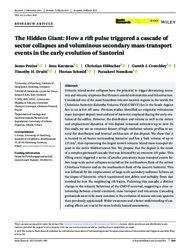The Hidden Giant: How a rift pulse triggered a cascade of sector collapses and voluminous secondary mass‐transport events in the early evolution of Santorini
DOI: https://doi.org/10.1111/bre.12667
Persistent URL: http://resolver.sub.uni-goettingen.de/purl?gldocs-11858/10196
Persistent URL: http://resolver.sub.uni-goettingen.de/purl?gldocs-11858/10196
Preine, Jonas; Karstens, Jens; Hübscher, Christian; Crutchley, Gareth J.; Druitt, Timothy H.; Schmid, Florian; Nomikou, Paraskevi, 2022: The Hidden Giant: How a rift pulse triggered a cascade of sector collapses and voluminous secondary mass‐transport events in the early evolution of Santorini. In: Basin Research, Band 34, 4: 1465 - 1485, DOI: 10.1111/bre.12667.
 |
Dokument öffnen: |
Volcanic island sector collapses have the potential to trigger devastating tsunamis and volcanic eruptions that threaten coastal communities and infrastructure. Considered one of the most hazardous volcano‐tectonic regions in the world, the Christiana‐Santorini‐Kolumbo Volcanic Field (CSKVF) lies in the South Aegean Sea in an active rift zone. Previous studies identified an enigmatic voluminous mass‐transport deposit west and east of Santorini emplaced during the early evolution of the edifice. However, the distribution and volume as well as the nature and emplacement dynamics of this deposit remained unknown up to now. In this study, we use an extensive dataset of high‐resolution seismic profiles to unravel the distribution and internal architecture of this deposit. We show that it is located in all basins surrounding Santorini and has a bulk volume of up to 125 km3, thus representing the largest known volcanic island mass‐transport deposit in the entire Mediterranean Sea. We propose that the deposit is the result of a complex geohazard cascade that was initiated by an intensive rift pulse. This rifting event triggered a series of smaller precursory mass‐transport events before large‐scale sector collapses occurred on the northeastern flank of the extinct Christiana Volcano and on the southeastern flank of the nascent Santorini. This was followed by the emplacement of large‐scale secondary sediment failures on the slopes of Santorini, which transitioned into debris and turbidity flows that traveled far into the neighboring rift basins. Following this cascade, a distinct change in the volcanic behaviour of the CSKVF occurred, suggesting a close relationship between crustal extension, mass transport and volcanism. Cascading geohazards seem to be more common in the evolution of marine volcanic systems than previously appreciated. Wider awareness and a better understanding of cascading effects are crucial for more holistic hazard assessments. Schematic Reconstruction of the Santorini Mass‐Transport Cascade (SMTC): After a phase of volcanic quiescence (A), a rift pulse (B) triggered precursory mass‐wasting events (C), large‐scale sector collapses (D) and secondary sediment failures (E), which culminated in a change in the volcanic behaviour of the system (F).
Statistik:
ZugriffsstatistikSammlung:
- Geologie [930]
Schlagworte:
Santorinimarine volcanic system
crustal extension
mass transport
volcanism
cascading effects
This is an open access article under the terms of the Creative Commons Attribution‐NonCommercial‐NoDerivs License, which permits use and distribution in any medium, provided the original work is properly cited, the use is non‐commercial and no modifications or adaptations are made.

